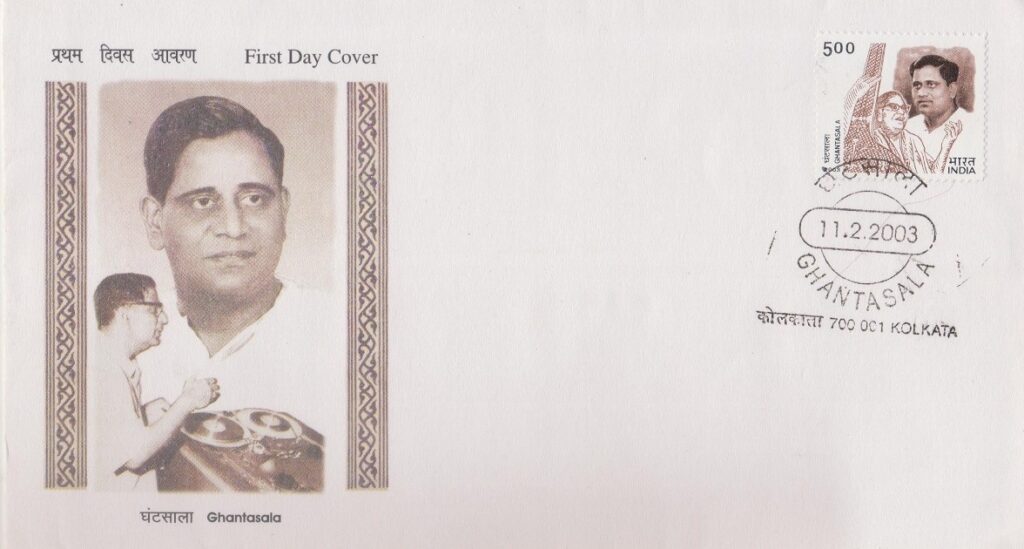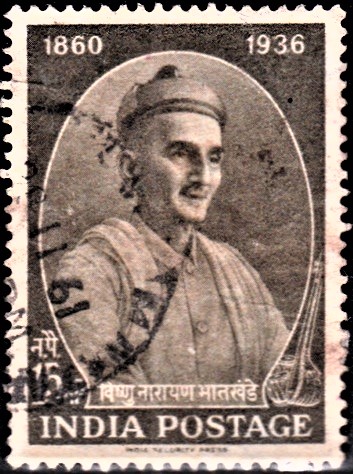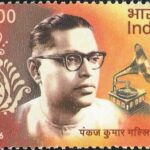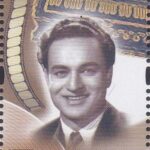
Ghantasala
A commemorative postage stamp on the Death Anniversary of ‘Gaana Gandharva‘ Ghantasala, a Telugu composer & playback singer :

 Issued by India
Issued by India
Issued on Feb 11, 2003
Issued for : The Department of Posts is happy to release a postage stamp in honour of Ghantasala who thrilled millions of people in our country with his melodious voice.
Credits :
Stamps & FDC : Sankha Samanta (Incorporating inputs from the Managing Director, A.P. State Film, Television and Theatre Development Corporation, Hyderabad)
Cancellation : Alka Sharma
Type : Stamp, Mint condition
Colour : Two Colour
Denomination : 500 Paise
Overall size : 3.34 x 2.88 cms.
Printing size : 2.99 x 2.53 cms.
Perforation : 13 x 13
Paper : Imported un w/m Adhesive Gravure Coated Stamp Paper in Sheet 50.8 x 53.5 cms
Stamps Printed : 0.4 million
Number per issue sheet : 42
Printing Process : Photogravure
Printer : India Security Press, Nashik
Name : Ghantasala Venkateswara Rao
Born on Dec 4, 1922 at Choutapalli, Gudivada, Krishna district, Madras Presidency, India
Died on Feb 11, 1974 at Chennai, Tamil Nadu, India
About :
- Ghantasala Venkateswara Rao (1922-1974), popularly known as Ghantasala, was one of the most popular playback singers of all time in Indian film industry. He was also an accomplished music director.
- Hailing from the Chowtapalli village of Andhra Pradesh, he lost his father, himself a musician, when eleven years old. Venkateswara, however, was not willing to be defeated by adversities and decided to pursue the study of music against all odds. Living on alms and sleeping in temples and inns he was able to pursue his studies at the Music College in Vizianagaram, winning the appreciation of all for his proficiency in classical Carnatic Music.
- In 1942 when he was twenty, he participated in the Freedom Struggle and was sentenced to 18 months of rigorous imprisonment for his involvement in the Quit India Movement. After his release from jail, Ghantasala came in contact with the poet-singer Samudrala Raghavacharya who introduced him to films.
- In 1947 he got his first break as an independent singer and one year later as a composer. Since then he had no occasion to look back. Singing 9,600 songs in playback and handling 102 films containing nearly two thousand different songs as a music director, his output was unusually prolific. More than the songs, it was the trends he set that made him stand apart. As a singer, according to experts, he inspired three generations of singers to imitate him. As a composer he harnessed Classical Ragas (modes of melody) to yield immensely popular tunes for films. In the genre of non-film songs he popularised poems set to melodious tunes, apart from devotional and patriotic songs.
- He has produced three films all of which had his own music. His fans, colleagues and the State and Central Governments conferred many honours upon him. Prominent among them was the Padmashri from the President of India. He was also made the Singer Laureate of Tirumala Tirupati Devasthanam, a coveted honorary post. He gave a number of benefit concerts in aid of charitable institutions, temples, churches, educational institutions, national defence fund organisations and cyclone relief funds.
- Text : Based on material received from the sponsors.







